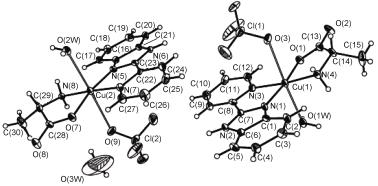1 Cui, L. J.; Xiao, S. Y.; Yang, H. S.; Xu, P.; Cheng, F. S.; Li, Z. H.; Liang, R. H.; Xia, Z. N. Chin. J. Org. Chem. 2011,31(5), 672 (in Chinese). (崔丽君, 肖尚友, 杨昊书, 徐盼, 程凡圣, 李正华, 梁荣 辉, 夏之宁, 有机化学, 2011, 31(5), 672.)  2 Bhattacharya, S.; Chaudhuri, P. Curr. Med. Chem. 2008,15(18), 1762.3 Choquesillo-Lazarte, D.; Covelo, B.; Gonzalez-Perez, J. M.; Casti?eiras, A.; Niclós-Gutiérrez, J. Polyhedron 2002,21(14~15), 1485. 2 Bhattacharya, S.; Chaudhuri, P. Curr. Med. Chem. 2008,15(18), 1762.3 Choquesillo-Lazarte, D.; Covelo, B.; Gonzalez-Perez, J. M.; Casti?eiras, A.; Niclós-Gutiérrez, J. Polyhedron 2002,21(14~15), 1485.  4 Mothilal, K. K.; Karunakaran, C.; Rajendran, A.; Murugesa, R. J. Inorg. Biochem. 2004, 98(2), 322.5 Lezcano, M.; Al-Soufi, W.; Novo, M.; Rodríguez-Nú?ez, E.; Tato, J. V. J. Agric. Food Chem. 2002, 50(1), 108.6 Devereux, M.; O'Shea, D.; Kellett, A.; McCann, M.; Walsh, M.; Egan, D.; Deegan, C.; K?dziora, K.; Rosair, G.; Müller-Bunz, H. J. Inorg. Biochem. 2007, 101(6), 881.7 El-Sherif, A. A.; Jeragh, B. J. A. Spectrochim. Acta Part A2007, 68A(3), 877.8 Geng, J.; Yu, H. J.; Zhang, H. Y.; Xu, H. X.; Qu, X. G. Prog. Chem. 2009, 21(5), 866 (in Chinese). (耿杰, 于海佳, 张海元, 徐海霞, 曲晓刚, 化学进展,2009, 21(5), 866.) 4 Mothilal, K. K.; Karunakaran, C.; Rajendran, A.; Murugesa, R. J. Inorg. Biochem. 2004, 98(2), 322.5 Lezcano, M.; Al-Soufi, W.; Novo, M.; Rodríguez-Nú?ez, E.; Tato, J. V. J. Agric. Food Chem. 2002, 50(1), 108.6 Devereux, M.; O'Shea, D.; Kellett, A.; McCann, M.; Walsh, M.; Egan, D.; Deegan, C.; K?dziora, K.; Rosair, G.; Müller-Bunz, H. J. Inorg. Biochem. 2007, 101(6), 881.7 El-Sherif, A. A.; Jeragh, B. J. A. Spectrochim. Acta Part A2007, 68A(3), 877.8 Geng, J.; Yu, H. J.; Zhang, H. Y.; Xu, H. X.; Qu, X. G. Prog. Chem. 2009, 21(5), 866 (in Chinese). (耿杰, 于海佳, 张海元, 徐海霞, 曲晓刚, 化学进展,2009, 21(5), 866.)  9 Lu, Y. M.; Ou, Z. B.; Liu, H. F.; Le, X. Y. Chin. J. Inorg. Chem. 2011, 27(4), 704 (in Chinese). (卢艳梅, 区志镔, 刘海峰, 乐学义, 无机化学学报, 2011,27(4), 704.) 9 Lu, Y. M.; Ou, Z. B.; Liu, H. F.; Le, X. Y. Chin. J. Inorg. Chem. 2011, 27(4), 704 (in Chinese). (卢艳梅, 区志镔, 刘海峰, 乐学义, 无机化学学报, 2011,27(4), 704.)  10 Yue, S. M.; Xu, H. B.; Ma, J. F.; Su, Z. M.; Kan, Y. H.; Zhang, H. J. Polyhedron 2006, 25(3), 635. 10 Yue, S. M.; Xu, H. B.; Ma, J. F.; Su, Z. M.; Kan, Y. H.; Zhang, H. J. Polyhedron 2006, 25(3), 635.  11 Sheldrick, G. M. SHELXTL, Version 5.10 ed., Bruker AXS Inc., Madsion, Wisconsion, USA, 1997. 11 Sheldrick, G. M. SHELXTL, Version 5.10 ed., Bruker AXS Inc., Madsion, Wisconsion, USA, 1997.  12 Geary, W. J. Coord. Chem. Rev. 1971, 7(1), 81. 12 Geary, W. J. Coord. Chem. Rev. 1971, 7(1), 81.  13 Nakamoto, K. Infrared and Raman Spectra of Inorganic and Coordination Compounds, 3rd Ed. Translated by Huang, D. Y.; Wang, R. Q., Chemical Industry Press, Beijing,1986, p. 237, p. 248 (in Chinese). (中本一雄, 无机和配位化合物的红外和拉曼光谱, 黄德 如, 汪仁庆译, 化学工业出版社, 北京, 1986, p. 237, p.248.) 13 Nakamoto, K. Infrared and Raman Spectra of Inorganic and Coordination Compounds, 3rd Ed. Translated by Huang, D. Y.; Wang, R. Q., Chemical Industry Press, Beijing,1986, p. 237, p. 248 (in Chinese). (中本一雄, 无机和配位化合物的红外和拉曼光谱, 黄德 如, 汪仁庆译, 化学工业出版社, 北京, 1986, p. 237, p.248.)  14 Subramanian, P. S.; Suresh, E.; Dastidar, P.; Waghmode, S.; Srinivas, D. Inorg. Chem. 2001, 40(17), 4291.15 Chen, J. Y.; Ren, X. X.; Le, X. Y.; Feng, X. L. Chin. J. Chem. 2010, 28(11), 2179.16 Patra, A. K.; Bhowmick, T.; Roy, S.; Ramakumar, S.; Chakravarty, A. R. Inorg. Chem. 2009, 48(7), 2932.17 Le, X. Y.; Gu, Q.; Song, Z. J.; Zhuang, C. X.; Feng, X. L. J. Coord. Chem. 2007, 60(13), 1359.18 Zhang, S. C.; Chun, X. G.; Chen, Y.; Zhou, J. L. Chin. J. Chem. 2011, 29(1), 65.19 Liu, X. P.; Yang, C.; Le, X. Y.; Zhou, X. H.; Wu, L. Y.; Chen, S. Chinese J. Inorg. Chem. 2003, 19(10), 1085 (in Chinese). (刘小平, 杨迟, 乐学义, 周晓华, 吴玲莹, 陈实, 无机化 学学报, 2003, 19(10), 1085.)20 Efthimiadou, E. K.; Thomadaki, H.; Sanakis, Y.; Raptopoulou, C. P.; Katsaros, N.; Scorilas, A.; Karaliota, A.; Psomas, G. J. Inorg. Biochem. 2007, 101(1), 64.21 Ren, X. X.; Chen, J. Y.; Le, X. Y. Chin. J. Chem. 2011,29(7), 1380.22 Zhang, S. C.; Zhu, Y. G.; Tu, C.; Wei, H. Y.; Yang, Z.; Lin, L. P.; Ding, J.; Zhang, J. F.; Guo, Z. J. J. Inorg. Biochem.2004, 98(12), 2099. 14 Subramanian, P. S.; Suresh, E.; Dastidar, P.; Waghmode, S.; Srinivas, D. Inorg. Chem. 2001, 40(17), 4291.15 Chen, J. Y.; Ren, X. X.; Le, X. Y.; Feng, X. L. Chin. J. Chem. 2010, 28(11), 2179.16 Patra, A. K.; Bhowmick, T.; Roy, S.; Ramakumar, S.; Chakravarty, A. R. Inorg. Chem. 2009, 48(7), 2932.17 Le, X. Y.; Gu, Q.; Song, Z. J.; Zhuang, C. X.; Feng, X. L. J. Coord. Chem. 2007, 60(13), 1359.18 Zhang, S. C.; Chun, X. G.; Chen, Y.; Zhou, J. L. Chin. J. Chem. 2011, 29(1), 65.19 Liu, X. P.; Yang, C.; Le, X. Y.; Zhou, X. H.; Wu, L. Y.; Chen, S. Chinese J. Inorg. Chem. 2003, 19(10), 1085 (in Chinese). (刘小平, 杨迟, 乐学义, 周晓华, 吴玲莹, 陈实, 无机化 学学报, 2003, 19(10), 1085.)20 Efthimiadou, E. K.; Thomadaki, H.; Sanakis, Y.; Raptopoulou, C. P.; Katsaros, N.; Scorilas, A.; Karaliota, A.; Psomas, G. J. Inorg. Biochem. 2007, 101(1), 64.21 Ren, X. X.; Chen, J. Y.; Le, X. Y. Chin. J. Chem. 2011,29(7), 1380.22 Zhang, S. C.; Zhu, Y. G.; Tu, C.; Wei, H. Y.; Yang, Z.; Lin, L. P.; Ding, J.; Zhang, J. F.; Guo, Z. J. J. Inorg. Biochem.2004, 98(12), 2099. |
